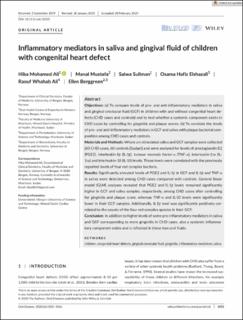| dc.contributor.author | Mohamed Ali, Hiba | |
| dc.contributor.author | Mustafa, Manal | |
| dc.contributor.author | Suliman, Salwa | |
| dc.contributor.author | Elshazali, Osama Hafiz | |
| dc.contributor.author | Ali, Raouf Wahab | |
| dc.contributor.author | Berggreen, Ellen | |
| dc.date.accessioned | 2021-06-29T11:57:43Z | |
| dc.date.available | 2021-06-29T11:57:43Z | |
| dc.date.created | 2021-01-14T15:22:12Z | |
| dc.date.issued | 2020 | |
| dc.Published | Oral Diseases. 2020, 26 (5), 1053-1061. | |
| dc.identifier.issn | 1354-523X | |
| dc.identifier.uri | https://hdl.handle.net/11250/2762343 | |
| dc.description.abstract | Objectives
(a) To compare levels of pro- and anti-inflammatory mediators in saliva and gingival crevicular fluid (GCF) in children with and without congenital heart defects (CHD cases and controls) and to test whether a systemic component exists in CHD cases by controlling for gingivitis and plaque scores. (b) To correlate the levels of pro- and anti-inflammatory mediators in GCF and saliva with plaque bacterial composition among CHD cases and controls.
Materials and Methods
Whole un-stimulated saliva and GCF samples were collected (60 CHD cases, 60 controls [Sudan]) and were analysed for levels of prostaglandin E2 (PGE2), interleukin-1β (IL-1β), tumour necrosis factor-α (TNF-α), interleukin-1ra (IL-1ra) and interleukin-10 (IL-10) levels. These levels were correlated with the previously reported levels of four red complex bacteria.
Results
Significantly elevated levels of PGE2 and IL-1β in GCF and IL-1β and TNF-α in saliva were detected among CHD cases compared with controls. General linear model (GLM) analyses revealed that PGE2 and IL-1β levels remained significantly higher in GCF and saliva samples, respectively, among CHD cases after controlling for gingivitis and plaque score, whereas TNF-α and IL-10 levels were significantly lower in their GCF samples. Additionally, IL-1β level was significantly positively correlated to the counts of the four red complex species in their GCF.
Conclusion
In addition to higher levels of some pro-inflammatory mediators in saliva and GCF corresponding to more gingivitis in CHD cases, also a systemic inflammatory component exists and is reflected in these two oral fluids. | en_US |
| dc.language.iso | eng | en_US |
| dc.publisher | Wiley | en_US |
| dc.rights | Navngivelse-Ikkekommersiell 4.0 Internasjonal | * |
| dc.rights.uri | http://creativecommons.org/licenses/by-nc/4.0/deed.no | * |
| dc.title | Inflammatory mediators in saliva and gingival fluid of children with congenital heart defect | en_US |
| dc.type | Journal article | en_US |
| dc.type | Peer reviewed | en_US |
| dc.description.version | publishedVersion | en_US |
| dc.rights.holder | Copyright 2020 The Authors. | en_US |
| cristin.ispublished | true | |
| cristin.fulltext | original | |
| cristin.qualitycode | 1 | |
| dc.identifier.doi | 10.1111/odi.13313 | |
| dc.identifier.cristin | 1871489 | |
| dc.source.journal | Oral Diseases | en_US |
| dc.source.40 | 26 | |
| dc.source.14 | 5 | |
| dc.source.pagenumber | 1053-1061 | en_US |
| dc.identifier.citation | Oral Diseases. 2020, 26 (5), 1053-1061 | en_US |
| dc.source.volume | 26 | en_US |
| dc.source.issue | 5 | en_US |

